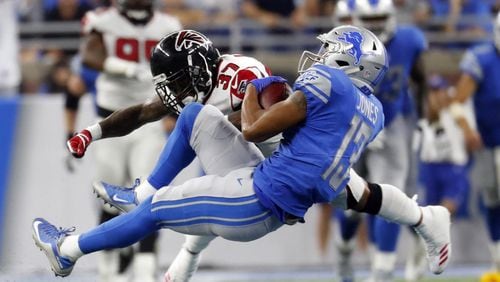Falcons coach Dan Quinn has become an expert on the NFL’s concussion protocol.
Running back Devonta Freeman, right tackle Ryan Schraeder and free safety Ricardo Allen have gone through the system this season and missed a total of six games (three exhibitions) and perhaps as much as 41 days.
Freeman went into the program Aug. 13 and was cleared Aug. 30.
Schraeder went into the program Sept. 17 and was back at practice Oct. 9 after the bye week. He could have been cleared before that Monday practice.
Allen went into the program Sept. 24 and was back at practice Oct. 9.
Once a player is diagnosed with a concussion or symptoms, the player goes in the concussion protocol, which is a five-step return-to-play process.
The player is immediately removed from the team setting with steps in place to work his way back to the team. A player can leave the protocol once all steps are cleared.
The five steps are rest and recovery, light aerobic exercise, light aerobic exercise and strength training, football specific drills and finally, football activity and clearance.
The recovery timetable varies with brain injuries. Some players make it back in a week, others with more severe concussion issues, take much longer.
Doctors not affiliated with the team monitor the process and then discuss when the team doctors when a player is ready to return.
“I’m very comfortable with how the league does it,” Quinn said Thursday. “As a coach, we really don’t have much insight and I really don’t ask a bunch of questions about it. It’s so far removed from our jurisdiction.”
Once the player has passed the clinical and cognitive tests administered by an independent doctor, the player see how his brain responds to athletic workouts.
“You just try to support the player as best that you can and encourage them when they are getting ready to go through the process with the conditioning part and the practice part,” Quinn said. “Once they go through that practice, once they tell me the independent person has cleared them, then we’re ready to go.”
Quinn is fine without have a say in the process.
“I generally find that its in my best interest to let the medical people do their thing,” Quinn said. “They don’t ask me about plays, so I appreciated that.”
Schraeder, who wears a specially designed $1,500 helmet, was injured early in the victory over Green Bay after he was hit in the back of the head.
“It was a weird play, and it didn’t look like much,” Schraeder said. “I pulled out there, and the corner was going to cut me. I went down and lowered my shoulder, and I was going to hit him with my shoulder, but he came here (pointing to the back of his head) with either the knee or the helmet. It hit me in the back of the head. Which was weird because I’ve (never been) hit in the back of the head. It just kind of got me.”
Schraeder was a little woozy and was diagnosed with a concussion. He’d never been in the concussion protocol.
“It was all new,” Schraeder said.
He’s aware of the connection between NFL brain injuries and chronic traumatic encepholopathy (CTE).
“At first, that’s always in the back of your mind (CTE),” Schraeder said. “You’re just kind of worried about that, but at the same time, if you take care of and do it the right way, go through the protocol and you let your brain heal and rest, that’s how you prevent stuff like that.
“It’s the constant injury on top of injury and playing through some things like that. … They were really smart about it.”
Schraeder complied with the doctor’s orders.
“If I had my symptoms, I’d tell them,” Schraeder said. “I’d be really honest with them. I think we did the right thing. I feel great now.”
Schraeder had his first full practice Monday, and he said the symptoms didn’t return.
“I feel 100 percent,” Schraeder said. “I can wait to play.”
Allen suffered a concussion late in the victory over Detroit when he leveled Lions wide receiver T.J. Jones with a thunderous hit. Jones bounced up after a 29-yard gain. Allen did not. He had a concussion.
“The team did a really good job of taking care of me and not rushing me back,” Allen said, not making the distinction that he was being attended to by an independent, non-team doctor. “Not forcing me to come back. They showed comfort through all of my time out. I’m just happy to be back.”
Allen said he is always aware of the connection to CTE in several former players and why the concussion protocols are in place.
“I understand the things that come with football, and I’m not trying to do anything to push those or hurt myself,” Allen said. “If it comes, I’m going to do all of the preventive things as far as taking a care of my body and taking care of myself. Eating the right foods and going to sleep. I’m going to do all I can to stay healthy.”
Allen plans to level the next wide receiver he sees crossing through his territory in the back of the Falcons’ defense.
“I’m not saying that I don’t care about it because it is a big deal,” Allen said. “But I don’t wake up everyday thinking that I’m going to go play football and get CTE.”
Freeman played only a series against Miami in the exhibition opener, but about one hour and 20 minutes into practice Aug. 13, he walked inside with a member of the training staff.
The Falcons initially thought his injury was heat-related. It as later was determined that he had a concussion.
“Right now, for the overwhelming majority of people and the overwhelming majority of time, a concussion is a clinical diagnosis,” said Dr. Vernon Williams, a sports neurologist and director of the Kerlan-Jobe Center for Sports Neurology and Pain Medicine at Kerlan-Jobe Orthopaedic Clinic in Los Angeles.
“We make the diagnosis based on the signs and symptoms along with the physical examination. We don’t have a widely available or frequently used test where we can put somebody in a machine and say, yeah, you had a concussion or not. It’s a combination of things.”
The Falcons’ training staff was on the ball that day.
“The key with that is that some of the symptoms are the same symptoms that people could have for other conditions,” Williams said, “and so that’s why you might have someone who has a headache and some nausea, but it wasn’t a concussion or maybe it was from a migraine or maybe it was from dehydration or heat illness or that kind of thing.”
Freeman missed a game in the 2015 season after he sustained a concussion against the Indianapolis Colts on Nov. 22.
The Falcons were in no rush to get Freeman back during the exhibition season. They wanted him ready for the regular-season opener.
“It made me realized how blessed I am to be able to come out here and compete, play the game that I love,” Freeman said about his time in the concussion protocol. “My job is what I love to do, and not too many people can say that in this world. So, it was definitely a reality check.”
About the Author







